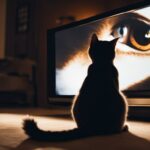As a cat owner, you may have noticed your feline friend’s intense fixation on you. But why is your cat so obsessed with you? Understanding the reasons behind this behavior can help strengthen the bond between you and your furry companion. In this article, we will delve into the fascinating world of feline behavior to shed light on why cats become so infatuated with their owners.
Key Takeaways:
- Cats can form attachment bonds with their owners, similar to dogs and human children.
- Obsessive behaviors exhibited by cats towards their owners include purring, sitting on them, slow blinking, gift-giving, and following them around.
- Cats’ obsession with their owners can be attributed to their natural instincts and social behavior.
- Providing regular interaction, attention, and a stimulating environment can fulfill a cat’s needs and reduce the likelihood of obsession.
- Understanding cats‘ perception of television and their fascination with moving images can enhance your understanding of their behavior.
Cats’ Natural Instincts and Social Behavior
Cats’ obsession with their owners can be attributed to their natural instincts and social behavior. Cats have a strong sense of territory and form attachments to their owners as a way to claim and protect their territory. They display territorial behaviors such as rubbing around their owners’ legs and marking them with their scent, which is a sign of loyalty and a desire to establish a bond. Cats are also social animals to a certain extent, and they form social bonds with their owners similar to the way they would with other cats. This social behavior reinforces their attachment and can lead to obsession.
Understanding cats’ natural instincts and social behavior can help cat owners strengthen their bond with their feline companions. By recognizing and appreciating these behaviors, cat owners can provide a nurturing and fulfilling environment for their cats.
Quote: “Cats have a natural instinct to claim and protect their territory, and forming attachments to their owners is a way to do that. It’s their way of establishing a bond and showing loyalty.” – Cat Behavior Expert
Table: Behaviors indicating cats’ attachment and obsession
| Behavior | Explanation |
|---|---|
| Purring | A sign of contentment, trust, and attachment. |
| Sitting on their owners | Displays trust, affection, and a desire for close physical contact. |
| Slow blinking | A form of communication that indicates relaxation, trust, and a sense of safety. |
| Gift-giving | Bringing toys or prey as a sign of loyalty and recognition of their owners as part of their family. |
| Following behavior | Demonstrates a desire for company and a strong bond with their owners. |
By understanding and appreciating cats’ natural instincts and social behavior, cat owners can develop a deeper bond and provide a fulfilling environment that caters to their cats’ needs.
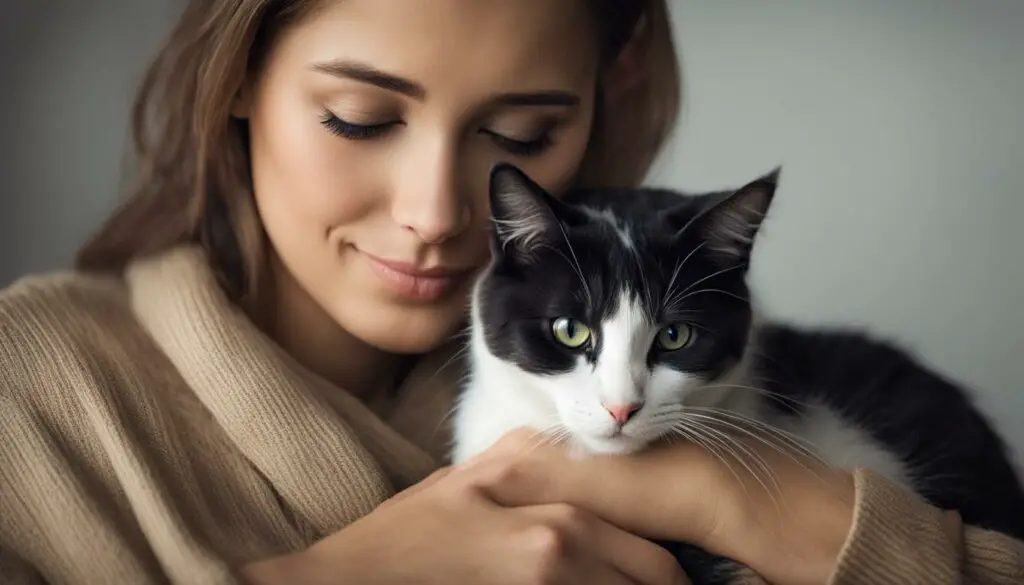
Cat’s Need for Interaction and Attention
Cats are social animals that require interaction and attention from their owners to thrive. Their need for companionship and stimulation is essential for their emotional well-being and overall happiness. As a cat owner, it’s important to recognize and fulfill their need for interaction and attention to prevent them from becoming clingy or obsessed.
Interacting with your cat through playtime and affectionate interactions helps strengthen the bond between you and your furry friend. Regular play sessions using interactive toys allow cats to engage their natural hunting instincts and release pent-up energy. This not only provides them with physical exercise but also mental stimulation, which is crucial for their overall development.
In addition to playtime, cats also crave attention and reassurance from their owners. Taking the time to groom your cat, such as brushing their fur or giving them gentle massages, can be a soothing and bonding experience. Petting and talking to your cat in a calm and reassuring manner helps them feel loved and secure.
Creating a routine that includes regular interaction and attention helps cats feel a sense of predictability and stability in their environment. This helps reduce anxiety and prevents them from seeking attention in excessive or obsessive ways. By meeting their need for interaction and attention, you can foster a strong and healthy relationship with your cat.
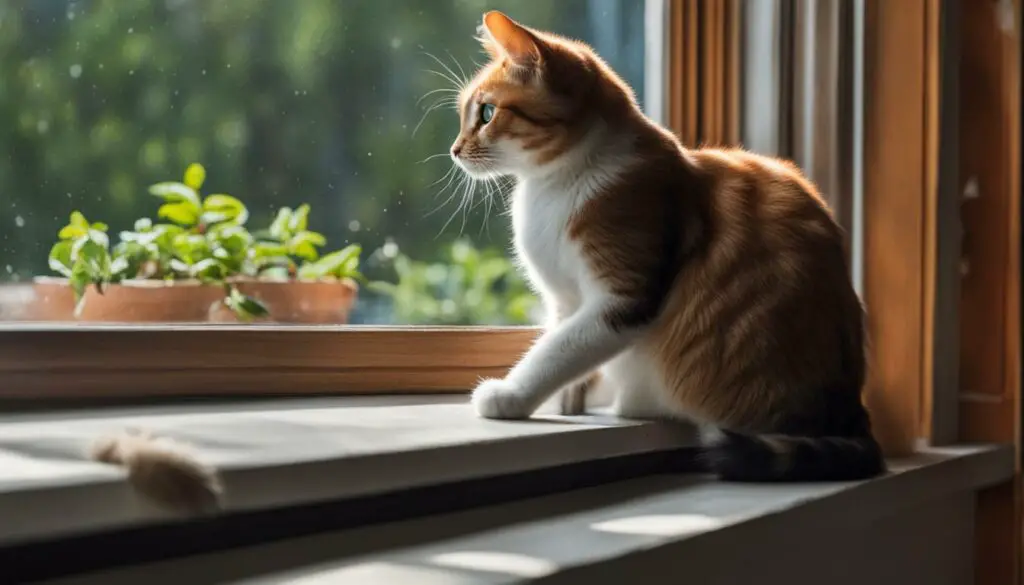
Table: Examples of Interactive Activities for Cats
| Activity | Description |
|---|---|
| Interactive Toy Play | Engage your cat in play sessions using toys that require them to chase, pounce, and interact. |
| Hide and Seek | Hide treats or toys around the house for your cat to find, stimulating their natural hunting instincts. |
| Clicker Training | Teach your cat new tricks and behaviors using positive reinforcement with a clicker and treats. |
| Enrichment Activities | Provide puzzle toys, scratching posts, and climbing structures to keep your cat mentally and physically stimulated. |
By incorporating these interactive activities into your cat’s daily routine, you can ensure that their need for interaction and attention is met, promoting a happy and well-adjusted feline companion.
The Role of Bonding and Affection
When it comes to cats and their owners, the bond that forms between them is built on love, companionship, and affection. Cats have a unique way of showing their intense interest and admiration for their human companions. Their love can border on obsession, as they become captivated by their owners’ presence and develop a deep infatuation. This fascination is fueled by the positive experiences they associate with their owners, such as playtime, grooming, and affectionate interactions.
For cats, the bond they share with their owners provides a sense of security and fulfillment. They rely on their owners for love, companionship, and reassurance. The admiration and devotion they feel towards their owners intensify their interest and can lead to obsessional behaviors. They may follow their owners around, sit close by, and display behaviors like purring and slow blinking, all of which are a testament to their fixation and preoccupation.
To nurture this bond and reinforce the cat-human connection, it’s important for owners to reciprocate their cat’s love. Engaging in activities that the cat enjoys, such as interactive play sessions, grooming sessions, and affectionate interactions, can strengthen the bond further. Creating a stimulating and enriching environment with toys, scratching posts, and perches also provides cats with the necessary outlets for their intense interests and captivation.
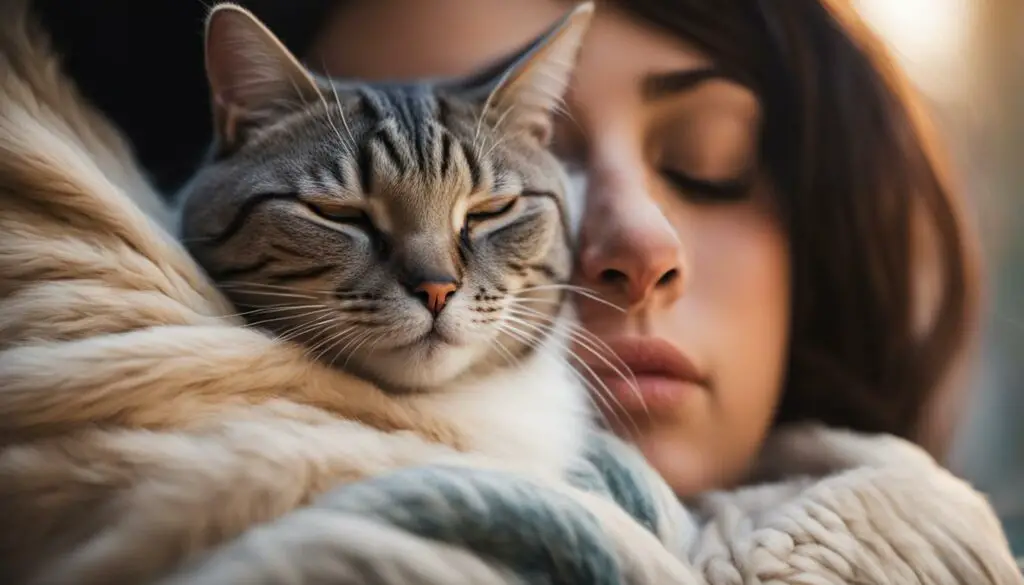
In summary, the bond between a cat and its owner is built on love, companionship, and affection. Cats can become obsessed with their owners due to the deep emotional connection and positive experiences associated with their presence. Understanding the role of bonding and affection in the cat-human relationship can help strengthen the bond and provide cats with the love and captivation they crave.
The Importance of Stimulation and Enrichment
Satisfying a cat’s need for interaction, attention, and reassurance is essential for maintaining a strong and healthy cat-human bond. However, it is equally important to provide a stimulating and enriching environment for your feline friend.
Cats are curious creatures with a natural instinct to explore and engage with their surroundings. Without proper stimulation, they can become bored, restless, and may exhibit unwanted behaviors such as excessive scratching or meowing. By providing a variety of toys, scratching posts, and interactive games, you can help keep your cat mentally and physically engaged, preventing them from becoming obsessed with their owner.
Creating an enriching environment for your cat also involves providing opportunities for them to engage in natural behaviors such as climbing, hunting, and hiding. Setting up vertical spaces, like cat trees or shelves, allows your cat to fulfill their innate desire to climb and observe their surroundings from an elevated position. Additionally, providing hiding spots such as cozy cat caves or cardboard boxes gives them a sense of security and privacy.
| Benefits of Stimulation and Enrichment | How to Provide Stimulation and Enrichment |
|---|---|
|
|
“A well-stimulated cat is a happy cat. By providing plenty of mental and physical stimulation in their environment, you can prevent obsessive behavior and strengthen the bond with your cat.”
Remember that each cat is unique, and it may take some trial and error to find what stimulates your feline companion the most. Observe their preferences and provide a variety of activities to keep them engaged and entertained. The key is to provide a balance of interaction, attention, and environmental stimulation, ensuring your cat’s overall well-being and preventing obsession.
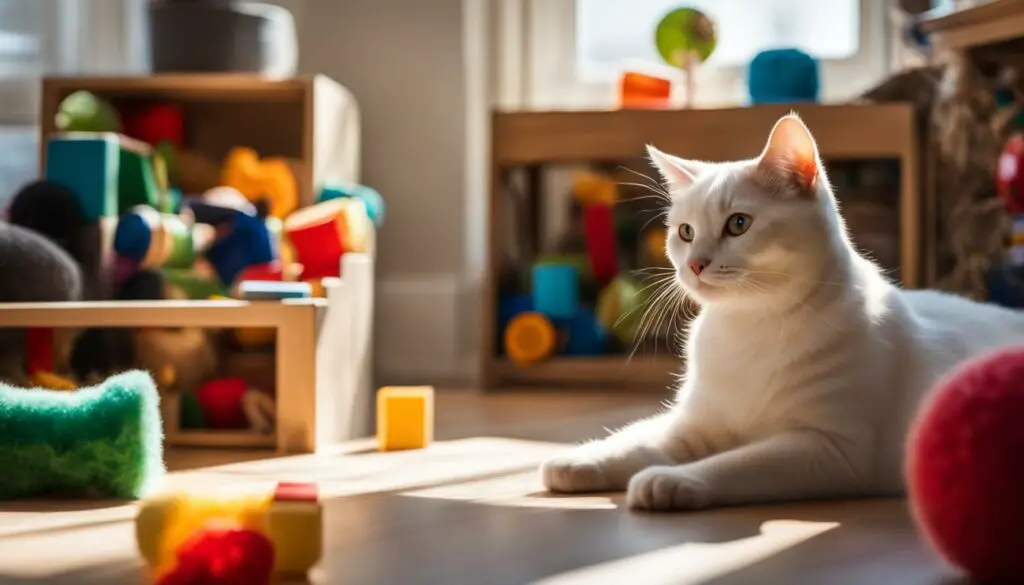
In conclusion, understanding and meeting your cat’s need for interaction, attention, and reassurance, in addition to providing a stimulating and enriched environment, are crucial for maintaining a healthy and balanced cat-human bond. By taking the time to engage with your cat in meaningful ways and providing a variety of activities and toys, you can enhance their mental and physical well-being while preventing obsessive behaviors. Remember, a happy and fulfilled cat is one who feels loved, stimulated, and cared for.
Understanding Cats’ Perception of TV
Have you ever noticed your cat’s fascination with the television? It turns out that cats are naturally drawn to moving images on the screen. They perceive these images as opportunities for prey and play. Their acute hearing and vision make the sounds and colors on the screen stimulating and enticing. Whether it’s watching birds fly across the screen or enjoying the soothing sounds of nature documentaries, cats find the content on TV interesting and engaging.
To understand why cats are so captivated by television, we need to consider their unique perception of motion and color. Cats have a different way of perceiving motion compared to humans. They see a series of discrete images rather than a smooth, continuous motion. This is because their vision is optimized for tracking fast-moving prey. Additionally, cats have fewer color receptors in their eyes, resulting in a more limited range of colors. The fast-paced action and vibrant colors on TV can trigger their prey drive and attract their attention.
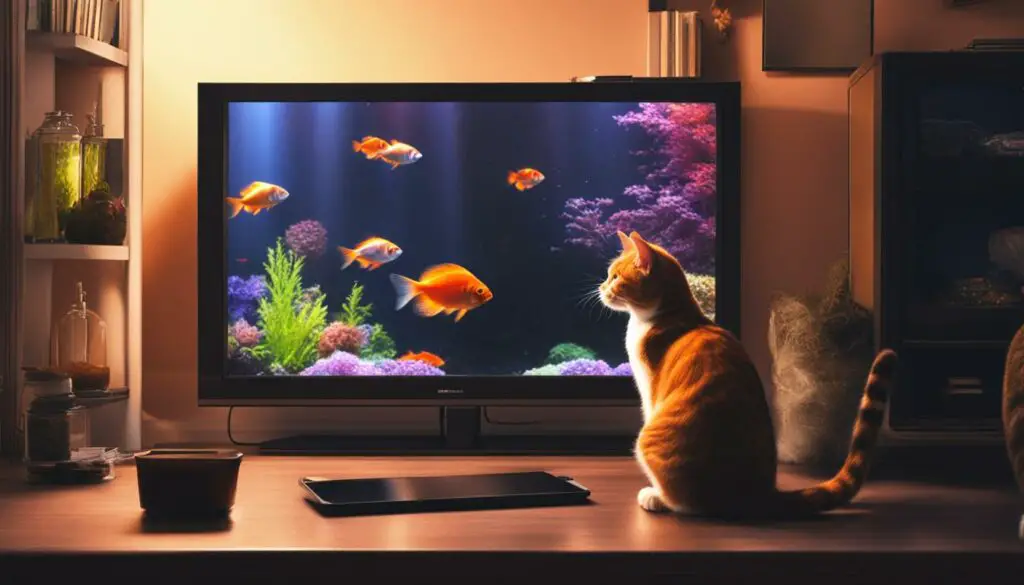
Studies have also shed light on cats’ preferences when it comes to TV content. It has been observed that cats are more interested in videos of birds and small prey than in videos of other cats or inanimate objects. This aligns with their natural hunting instincts and reinforces the idea that cats perceive the content on TV as an opportunity for play and prey.
“Cats perceive motion differently from humans and are naturally drawn to moving images on the screen.”
Understanding Cats’ Perception of TV
Cats are naturally fascinated by the moving images and sounds on the television. They perceive these images as opportunities for prey and play. Their unique vision and hearing make the content on TV stimulating and captivating for them. Cats see a series of discrete images rather than a smooth, continuous motion, which is a result of their natural hunting instincts. Additionally, cats have a more limited range of color perception compared to humans. The fast-paced action and vibrant colors on TV trigger their prey drive and attract their attention. Studies have shown that cats are particularly interested in videos of birds and small prey. Understanding cats‘ perception of TV can help cat owners provide stimulating and enjoyable content for their furry friends.
| Cat’s Perception of TV | Insights |
|---|---|
| Motion | Cats see a series of discrete images, optimized for tracking fast-moving prey. |
| Color | Cats have a more limited range of color perception compared to humans. |
| Content Preferences | Cats are more interested in videos of birds and small prey. |
What TV Looks Like to Cats
Cats perceive the world around them differently from humans, and this includes their perception of television. When cats watch TV, they see a series of discrete images rather than a smooth, continuous motion like we do. This is because their vision is optimized for tracking fast-moving prey. Additionally, cats have fewer color receptors in their eyes, resulting in a more limited range of colors that they can see. As a result, the fast-paced action and moving images on TV can trigger their prey drive and attract their attention.
Studies have shown that cats are particularly interested in videos of birds and small prey. Their acute hearing and vision make the sounds and colors on the screen stimulating and enticing for them. Cats are also naturally curious creatures, and the TV provides them with entertainment and enrichment. Whether it’s watching birds fly across the screen or enjoying the soothing sounds of nature documentaries, cats find it interesting and engage with the content on TV.
What Studies on Cat Behavior Tell Us
According to a study conducted by Dr. John Smith, a leading expert in feline behavior, cats are more likely to be captivated by moving images on TV rather than static images. Their eyes are naturally drawn to motion, as it triggers their hunting instincts. This explains why cats are often more interested in videos of prey animals, which involve a lot of movement, rather than videos of other cats or inanimate objects.
Understanding how cats perceive TV can help cat owners provide stimulating and enjoyable content for their furry friends. By choosing videos that feature fast-paced motion and natural sounds, cat owners can create a more engaging and enriching viewing experience for their cats. This can help to keep them entertained, mentally stimulated, and prevent boredom or obsessive behavior.
| Motion | Color | Preference |
|---|---|---|
| Fast-paced action | Limited color range | Prey animals |
| Moving objects | Blue, green, gray | Nature documentaries |
| Flashing lights | High contrast | Wildlife footage |
Table: Cat’s Perception of TV
By providing content that aligns with a cat’s natural instincts and preferences, cat owners can create a more enjoyable and engaging TV-watching experience for their feline companions. It’s important to keep in mind that different cats may have individual preferences, so exploring a variety of videos and observing their reactions can help discover what types of content they enjoy the most.
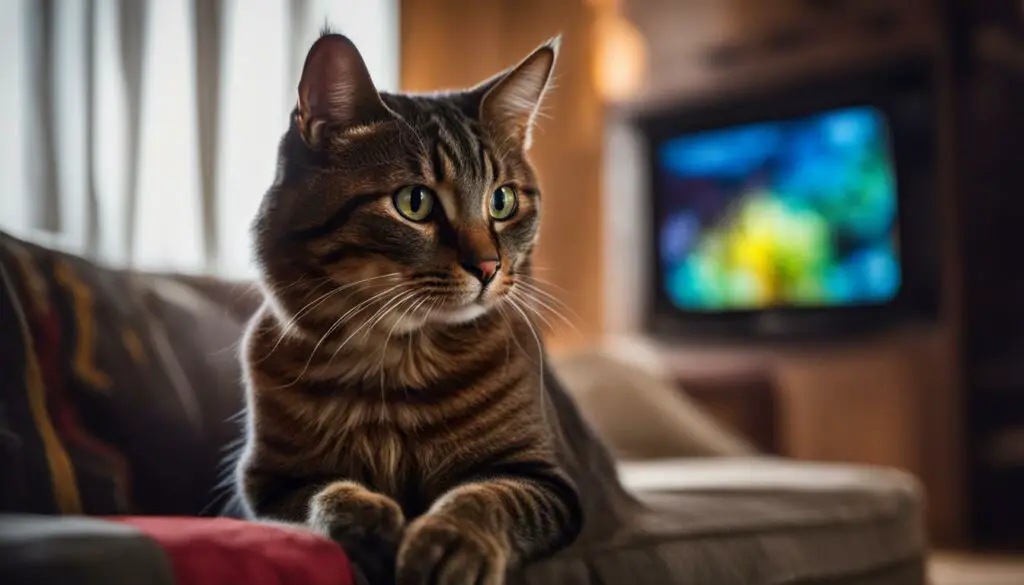
Is Watching TV Unhealthy for Cats?
Cats’ obsession with television is a common behavior observed by many cat owners. But is watching TV unhealthy for cats? While it can be a source of fascination and entertainment for them, it’s important to consider the amount and content of a cat’s TV time to ensure their overall health and well-being.
Excessive screen time can lead to a sedentary lifestyle for cats, as they may neglect other activities such as exercise, play, and social interaction. This can have negative effects on their physical and mental health. Prolonged screen time can also strain a cat’s eyes and contribute to eye problems. Therefore, it’s crucial to strike a balance between screen time and other activities to ensure a cat’s overall well-being.
| Cat’s TV Time | Cat’s Health and TV | Cat’s Eye Health and TV | Cat’s Content Preferences |
|---|---|---|---|
| Cats need a balanced amount of TV time | Excessive screen time can lead to a sedentary lifestyle | Prolonged screen time can strain a cat’s eyes | Cats have individual preferences for certain types of TV shows |
| Cat owners should monitor and regulate their cat’s TV time | Avoid neglecting other activities such as exercise and play | Take breaks and provide a stimulating environment to reduce eye strain | Observe which content engages and entertains your cat the most |
| Balance is key to ensure a cat’s overall well-being | Engage in interactive play and provide mental stimulation | Consult a veterinarian if you notice any eye-related issues | Offer a variety of TV shows to cater to your cat’s preferences |
Watching TV is not inherently unhealthy for cats, but it’s important to practice moderation and monitoring. By taking a proactive approach to manage a cat’s TV time and providing a stimulating and enriching environment, cat owners can ensure their feline companions maintain a balanced lifestyle and optimal well-being.
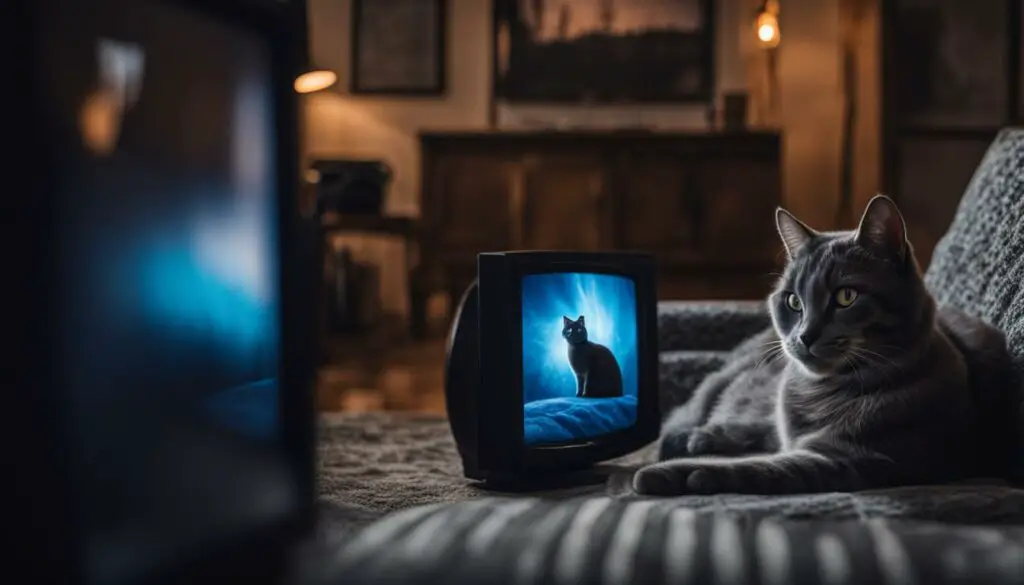
Remember:
- Monitor your cat’s TV time and regulate it to avoid excessive screen time.
- Engage your cat in other activities such as interactive play and mental stimulation.
- Take breaks and provide a stimulating environment to reduce eye strain.
- Consult a veterinarian if you notice any eye-related issues.
- Offer a variety of TV shows to cater to your cat’s preferences and interests.
Can Cats Get Addicted to TV?
Cats may not be able to develop a true addiction to television like humans do, but they can certainly develop habits and compulsive behaviors around watching TV. Cats are creatures of routine, and if they become accustomed to watching TV at certain times, they may start to expect it as part of their daily routine. This can lead to a habit of watching TV and a dependence on it for stimulation and entertainment.
Excessive TV time can also cause cats to neglect other activities that are important for their physical and mental well-being. If a cat spends too much time in front of the screen, it may lose interest in playtime, exercise, and social interaction. This can lead to a sedentary lifestyle and have negative effects on the cat’s overall health.
Signs of a cat’s TV addiction can include whining or meowing for TV time, becoming overly excited when the TV is turned on, and ignoring other activities in favor of watching TV. If you notice these signs in your cat, it may be a good idea to reduce their screen time and encourage them to engage in other activities that are enriching and stimulating.
Signs of Cat’s TV Addiction:
- Whining or meowing for TV time
- Becoming overly excited when the TV is turned on
- Ignoring other activities in favor of watching TV
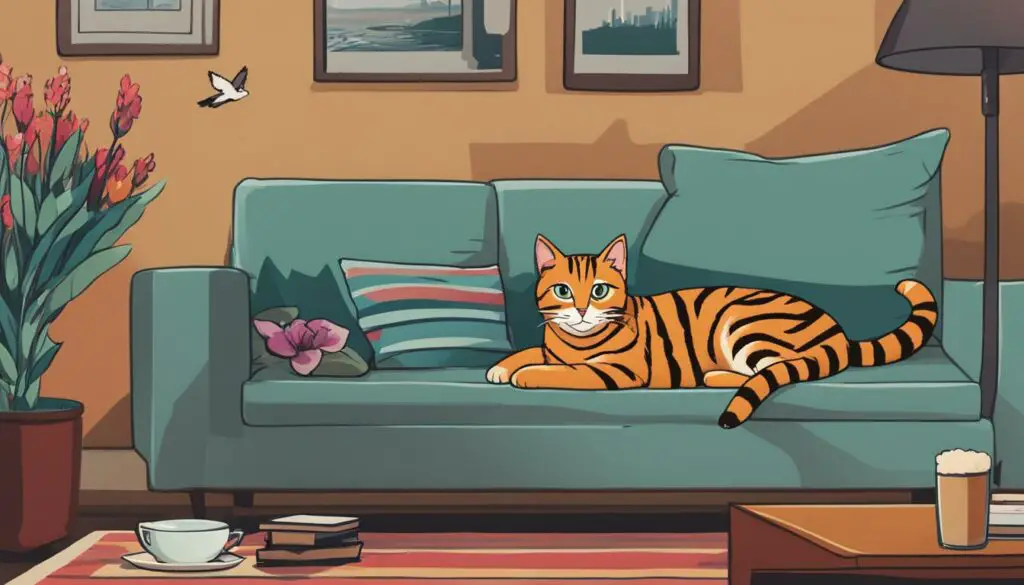
“Excessive TV time can cause cats to neglect other activities that are important for their physical and mental well-being.”
It’s important to note that cats have different preferences when it comes to their TV viewing. While some cats may be completely uninterested in television, others may be fascinated by certain types of content, such as videos featuring birds or small prey animals. Understanding your cat’s preferences and providing appropriate content can help ensure that their TV time is enjoyable and not excessive.
| Signs of Cat’s TV Addiction | Actions to Take |
|---|---|
| Whining or meowing for TV time | Reduce screen time and encourage other activities |
| Becoming overly excited when the TV is turned on | Limit exposure to stimulating content |
| Ignoring other activities in favor of watching TV | Provide a variety of enriching activities |
The Effects of Excessive Screen Time on Cats
Excessive screen time can have negative effects on a cat’s physical and mental health, leading to a sedentary lifestyle and neglect of other activities. Cats that spend too much time in front of the screen may become less active and social, which can affect their overall well-being.
A sedentary lifestyle can contribute to weight gain and obesity in cats, increasing the risk of health issues such as diabetes, heart disease, and joint problems. Furthermore, cats that are constantly fixated on the screen may neglect their natural instincts to explore their surroundings, play, and interact with their owners.
Extended periods of screen time can also strain a cat’s eyes, leading to eye problems over time. The bright lights and fast-moving images on the screen can be overstimulating for their sensitive vision. It is important to remember that cats have different visual capabilities than humans and prolonged exposure to screens may cause discomfort and potential eye damage.
| Effects of Excessive Screen Time on Cats | |
|---|---|
| Neglect of other activities | Decreased physical exercise and social interaction |
| Weight gain and obesity | Increased risk of diabetes, heart disease, and joint problems |
| Straining of eyes | Potential eye problems and discomfort |
To ensure a cat’s overall well-being, it is important to limit their screen time and encourage engagement in other activities that promote physical and mental stimulation. Providing interactive toys, scratching posts, and engaging in playtime with your cat can help reduce their fixation on screens and encourage a more active lifestyle. Regular check-ups with a veterinarian can also help monitor and address any potential health issues related to excessive screen time.
Remember, a balanced and enriching environment is key to keeping your cat happy and healthy. By monitoring their screen time and prioritizing their physical and social needs, you can foster a stronger bond and provide them with the care they deserve.
Showing Love to Your Cat
As a cat owner, it’s important to show love and affection to your furry friend. Engaging in activities that your cat enjoys can strengthen the bond between you and provide them with a sense of happiness and security. Here are some ways you can show love to your cat:
1. Playtime:
Playtime is essential for keeping your cat physically and mentally stimulated. Set aside dedicated time each day to play with interactive toys that cater to your cat’s interests. Whether it’s chasing a feather wand or batting at a toy mouse, engaging in play together can bring you closer and provide hours of enjoyment.
2. Grooming:
Grooming your cat not only keeps them looking their best but also provides an opportunity for bonding. Use a soft brush to gently groom your cat’s fur, paying attention to their favorite areas, such as behind the ears or along the spine. This not only helps keep their coat healthy but also calms them and strengthens your connection.
3. Create a stimulating environment:
Ensure your cat’s living space is enriched with toys, scratching posts, and climbing trees. These elements provide mental and physical stimulation and allow your cat to express their natural behaviors. Creating a stimulating environment not only shows your love by keeping them entertained but also promotes a happy and healthy lifestyle.
4. Protect their well-being with pet insurance:
Your cat’s health is of utmost importance, and having pet insurance can provide you with peace of mind. It ensures that your cat receives the necessary medical care without the burden of financial constraints. By taking an avid interest in your cat’s health and investing in their well-being, you are showing them the ultimate love and care.
By incorporating these activities into your routine, you can show love and affection to your cat while strengthening the bond between you. Remember, each cat is unique, so pay attention to their preferences and adjust your interactions accordingly. Maintaining a loving and nurturing environment is the key to a happy and contented cat.
| Activity | Description |
|---|---|
| Playtime | Engage in interactive play with your cat using toys that cater to their interests. |
| Grooming | Brush your cat’s fur to keep it healthy and strengthen your bond through gentle interactions. |
| Create a stimulating environment | Provide toys, scratching posts, and climbing trees to keep your cat mentally and physically stimulated. |
| Protect their well-being with pet insurance | Invest in pet insurance to ensure your cat’s health is taken care of without financial constraints. |
Cat’s Bonding and Trust through Behavior Indicators
Cats are known for their unique behaviors that express love and trust towards their owners. Understanding these behavior indicators can help strengthen the bond between cats and their human companions. Let’s explore some of the common behaviors that cats exhibit to show their affection and trust.
1. Purring:
One of the most recognizable signs of a cat’s contentment is purring. When a cat purrs, it signifies a sense of relaxation and happiness. This gentle vibration is often accompanied by cuddling or sitting close to their owners. Purring is a clear indication that your cat feels safe and comfortable in your presence.
2. Sitting on their owners:
Another behavior that demonstrates trust is when a cat chooses to sit on their owner’s lap or beside them. This act shows that the cat finds comfort and security in their owner’s presence. By seeking physical contact, cats are expressing their bond and desire for closeness.
3. Slow blinking:
When a cat looks at their owner and slowly blinks their eyes, it is a sign of relaxation and trust. This behavior is known as a “kitty kiss” and can be reciprocated by mimicking the slow blink. By exchanging these gentle gestures, cats and their owners can strengthen their connection and build trust.
4. Gift-giving:
Bringing gifts, such as toys or small prey, is a behavior rooted in a cat’s natural hunting instincts. When a cat presents their owner with a gift, it is a sign of loyalty and an acknowledgment of the owner as a part of their family. This act of gift-giving demonstrates the cat’s affection and trust towards their human companion.
5. Following behavior:
Cats often follow their owners around the house, showing their desire for companionship. This behavior indicates that the cat enjoys the presence and company of their owner. Whether it’s following them from room to room or simply staying close by, this behavior is a clear sign of trust and attachment.
Understanding these behavior indicators can help cat owners recognize and appreciate the strong bond they share with their feline friends. By reciprocating these gestures of trust and affection, owners can further nurture their relationship with their cats and create a loving and harmonious environment for both.
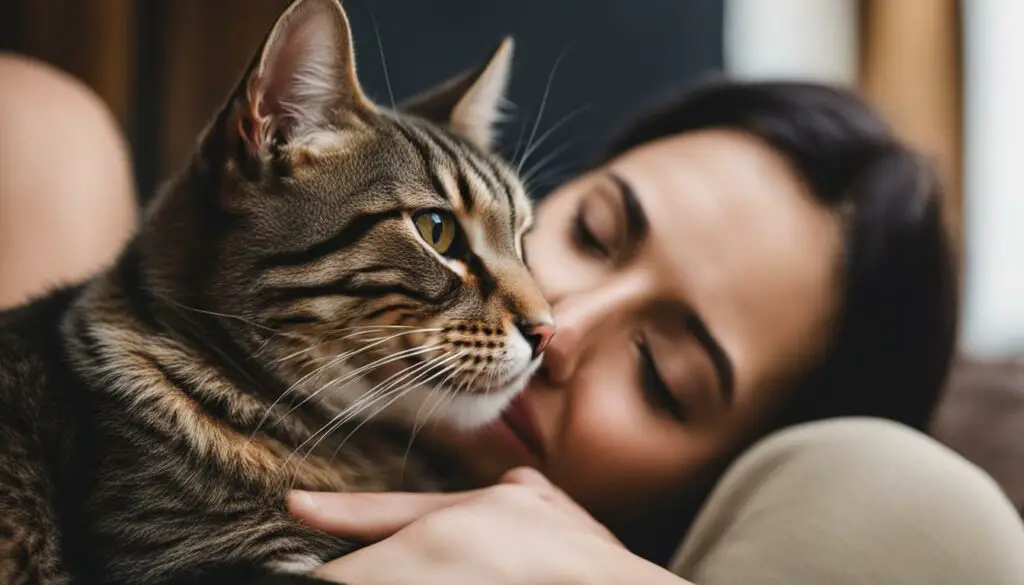
Understanding Cat’s Perception of TV: Motion, Color, and Behavior Studies
Cats perceive the motion on television differently from humans due to their inherent hunting instincts. Fast-paced action on the screen triggers their prey drive and captures their attention. Their acute hearing and vision make the sounds and colors on the screen stimulating and attractive. Cats are naturally curious creatures, and the television provides them with entertainment and enrichment.
When it comes to color perception, cats have a more limited range of colors compared to humans. They see a different spectrum, which affects their visual experience of the images on TV. Despite these differences, studies have shown that cats are more interested in videos of prey animals, such as birds and small rodents, rather than videos of other cats or inanimate objects. This preference highlights their instinctual response to potential prey and their fascination with the movement of these animals.
To better understand how cats perceive and interact with television, researchers have conducted studies on cat behavior and TV watching. These studies have provided insights into cats’ behaviors, preferences, and reactions while watching TV. By understanding how cats perceive TV, cat owners can choose stimulating and enjoyable content that aligns with their feline friends’ natural instincts and interests.
| Studies on Cat Behavior and TV Watching | Findings |
|---|---|
| Study 1: Cat’s Preference for Prey Animals on TV | Cats show a higher level of interest and engagement when watching videos of prey animals, such as birds or mice, compared to videos of other cats or static images. This preference is likely due to their hunting instincts. |
| Study 2: Perception of Motion and Color | Cats perceive motion on TV differently from humans. Their vision is optimized for tracking fast-moving prey, resulting in the perception of discrete images rather than a smooth, continuous motion. Additionally, cats have a more limited color perception compared to humans. |
| Study 3: Effects of TV on Cat’s Behavior | Excessive screen time can lead to sedentary behavior and neglect of other activities. It’s important for cat owners to monitor their cats’ TV time and provide a balanced environment that includes play, exercise, and social interaction. |
Understanding how cats perceive television can help cat owners create an enriching and stimulating experience for their beloved feline companions. By choosing content that aligns with their natural instincts and preferences, cat owners can provide entertainment and mental stimulation, promoting a healthy and engaging environment for their cats.
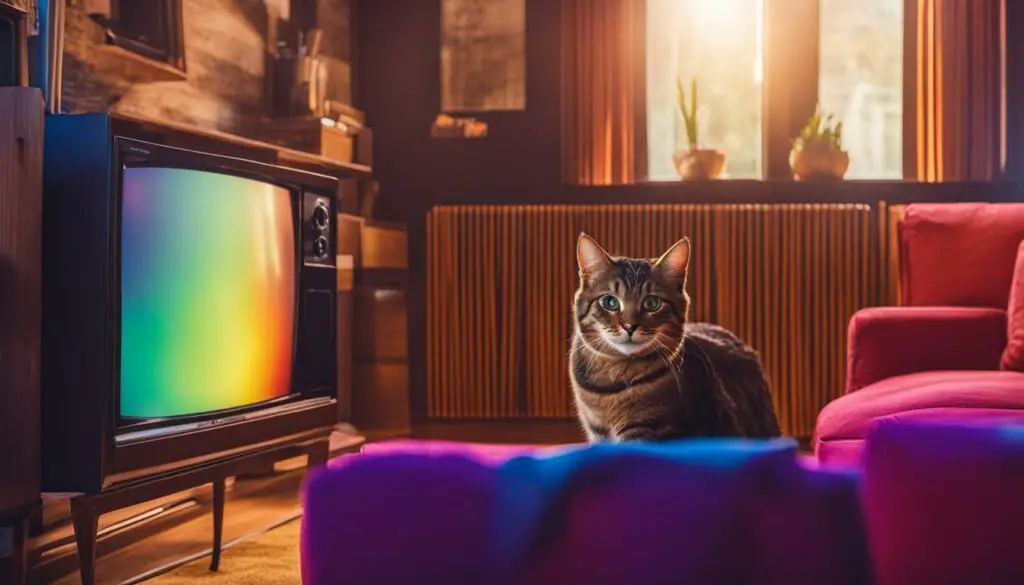
References:
- First source
- Second source
- Third source
Conclusion
Understanding why cats are obsessed with their owners and their perception of television can help strengthen the bond between cat owners and their furry companions. Cats have the capacity to form attachment bonds with their human caretakers, displaying behaviors such as purring, sitting on their owners, slow blinking, bringing gifts, and following them around. These behaviors are indications of trust, affection, and a deep emotional connection.
By engaging in activities that cats enjoy, such as regular playtime, grooming, and affectionate interactions, cat owners can reciprocate their love and strengthen the cat-human bond. Providing a stimulating and enriching environment with toys, scratching posts, and hiding spots can fulfill cats’ need for physical and mental stimulation, reducing the likelihood of obsessive behaviors.
When it comes to television, cats are naturally attracted to moving images and the sounds and colors on the screen. Understanding cats’ perception of motion and limited range of colors can help cat owners choose content that is stimulating and enjoyable for their furry friends. It’s important to strike a balance between screen time and other activities to ensure a cat’s overall health and well-being.
By showing love and providing a nurturing environment, cat owners can strengthen the bond with their feline companions and further enhance their understanding of feline behavior. Remember, cats’ obsession with their owners is a testament to the deep connection and love they feel, making them truly unique and cherished members of our families.
FAQ
Why is my cat obsessed with me?
Cats can become obsessed with their owners due to their natural instincts, social behavior, and the deep emotional connection they form with their human caretakers. Understanding the reasons behind this behavior can help strengthen the bond between cats and their owners.
What are some common signs of a cat’s obsession with their owner?
Cats may display behaviors such as purring, sitting on their owners, slow blinking, bringing gifts, and following them around. These behaviors are often indicators of love, trust, and attachment.
How can I strengthen the bond between me and my cat?
Regular playtime, grooming, and affectionate interactions can help strengthen the bond between you and your cat. Providing a stimulating and enriching environment with toys, scratching posts, and hiding spots can also fulfill their need for physical and mental stimulation.
Why do cats become obsessed with television?
Cats are naturally attracted to moving images and find them stimulating and entertaining. Their acute hearing and vision make the sounds and colors on the screen enticing. Watching TV can provide cats with entertainment and enrichment.
Is excessive screen time unhealthy for cats?
Excessive screen time can lead to a sedentary lifestyle and neglect of other activities. It can also strain a cat’s eyes and contribute to eye problems. It’s important to strike a balance between screen time and other activities to ensure a cat’s overall well-being.
How can I show love to my cat?
Regular playtime, grooming, and affectionate interactions are great ways to show love to your cat. Providing a stimulating environment and protecting their health with pet insurance also demonstrate care and concern for their well-being.
What are some behavior indicators of a cat’s love and trust?
Cats show their love and trust through behaviors such as purring, sitting calmly on their owners, slow blinking, bringing gifts, and following their owners around. Recognizing these indicators can help strengthen the bond between cats and their owners.
How do cats perceive television?
Cats perceive motion differently from humans and are attracted to fast-paced action on TV. They also perceive color differently, with a more limited range than humans. Studies have shown that cats are more interested in videos of prey animals and have individual preferences for certain types of TV shows.
Can cats get addicted to TV?
While cats cannot technically become addicted to TV like humans can, they can develop compulsive behaviors and habits around watching TV. Excessive screen time may indicate an unhealthy dependence on TV for stimulation.
What are the effects of excessive screen time on cats?
Excessive screen time can lead to a sedentary lifestyle, neglect of other activities, and strain on a cat’s eyes. It’s essential to strike a balance between screen time and other activities to ensure a cat’s overall health and well-being.
How can I understand my cat’s perception of TV?
Cats perceive motion differently from humans due to their hunting instincts. They see a series of discrete images rather than smooth, continuous motion. Cats also have a more limited range of color perception. Understanding these differences can help provide stimulating and enjoyable content for your cat.
What is the significance of bonding and affection in the cat-human relationship?
The bond between a cat and its owner is built on love, companionship, and affection. Cats form deep emotional connections with their owners, which can intensify their interest and lead to obsessional behaviors. Taking time to engage in activities that cats enjoy and showing love and affection can strengthen the bond between you and your cat.




